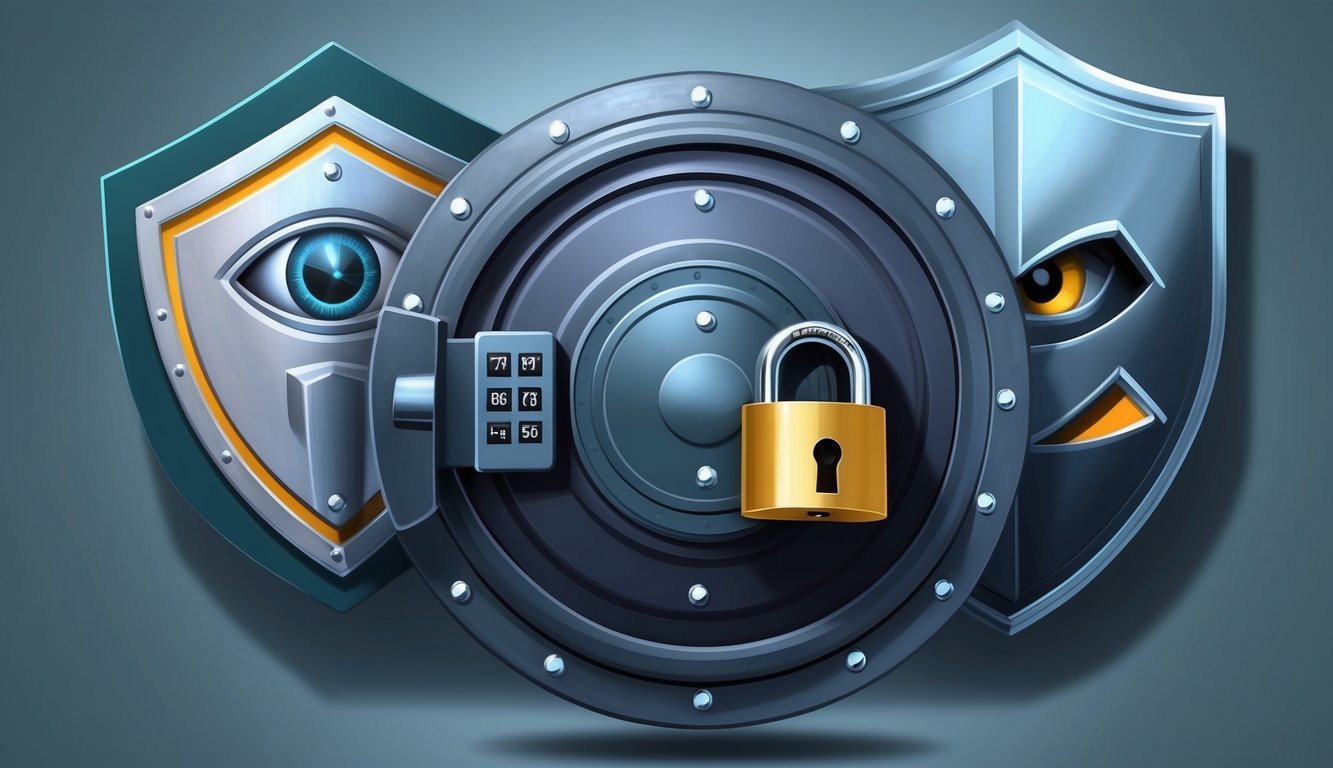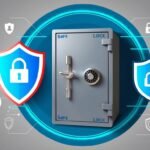Crypto can be exciting, but keeping it safe is key. You’ve worked hard for your digital assets, so protecting them should be a top priority. With hackers and scammers always looking for ways to steal crypto, you need to stay on your toes.

Keeping your crypto secure involves using strong passwords, enabling two-factor authentication, and storing large amounts in cold wallets.
These steps help guard against unauthorized access to your digital wealth.It’s also smart to be cautious of phishing attempts and only use trusted exchanges for transactions.
Stay up-to-date on the latest security practices in the crypto world. As technology changes, so do the methods used by bad actors. By learning and adapting, you can better protect your investments and enjoy the benefits of cryptocurrency with peace of mind.
Key Takeaways
- Use strong security measures like complex passwords and two-factor authentication for your crypto accounts
- Store large amounts of crypto in cold wallets for enhanced safety
- Stay informed about new security threats and adapt your protection strategies accordingly
Setting Up Your Crypto Wallet
Getting your crypto wallet set up right is super important for keeping your digital coins safe. Let’s look at how to choose a good wallet and use it the smart way.
Choosing a Secure Wallet
When picking a crypto wallet, go for one that’s well-known and trusted. Look for wallets with good reviews and strong security features. Some popular options include Ledger, Trezor, and MetaMask.
Make sure the wallet you choose supports the types of crypto you want to use. Some wallets work with lots of different coins, while others are just for one or two.
Don’t forget about ease of use. You want a wallet that’s simple to navigate, especially if you’re new to crypto.
Understanding Hot vs. Cold Wallets
Hot wallets are connected to the internet. They’re easy to use for everyday transactions but can be more vulnerable to hacks.
Cold wallets, like hardware wallets, aren’t connected to the internet. They’re safer but not as convenient for quick trades.
Many crypto fans use both types. They keep most of their coins in a cold wallet for safety and a smaller amount in a hot wallet for easy spending.
The Role of Private Keys
Private keys are like the password to your crypto stash. They prove you own your coins and let you spend them.
Never share your private keys with anyone. If someone gets them, they can take all your crypto.
Some wallets let you write down your private keys as a series of words. This is called a seed phrase. Keep it somewhere super safe, like a locked drawer or safe deposit box.
Consider using a password manager to keep your wallet passwords and seed phrases secure. Just make sure to use a really strong master password for the manager itself.
Using Multi-Signature Wallets for Enhanced Security
Multi-signature (or multi-sig) wallets need more than one person to approve transactions. This adds an extra layer of safety.
They’re great for businesses or if you’re managing crypto with others. Even if one person’s keys are stolen, the thief can’t take the funds without the other signatures.
Setting up a multi-sig wallet is a bit more complex, but it can be worth it for the added security. Just make sure all users understand how it works.
Some exchanges and wallet providers offer multi-sig options. Do your research to find one that fits your needs.
Protecting Your Crypto From Scams and Hackers
Keeping your crypto safe is crucial. Bad guys are always trying to trick you out of your digital coins. Let’s look at some key ways to guard your crypto from scammers and hackers.
Avoiding Phishing Attacks
Phishing attacks are sneaky tricks to steal your info. Watch out for fake emails or sites that look real. They might ask for your wallet keys or passwords.
Don’t click links in emails about your crypto. Go straight to the real site instead. Check the web address carefully. Scammers use URLs that look almost right.
Use bookmarks for your crypto sites. This helps you avoid typing in the wrong address by mistake.
Be wary of urgent messages. Real companies won’t pressure you to act fast. When in doubt, contact support through the official site.
Guarding Against SIM-Swap and Account Takeovers
SIM-swap attacks can give hackers control of your phone number. This lets them get into accounts that use text message codes.
Use an authenticator app instead of SMS for two-factor authentication (2FA). Google Authenticator or Authy are good choices.
Set up a PIN with your phone company. This makes it harder for someone to swap your SIM.
Use unique, strong passwords for each account. A password manager can help you create and remember them.
Enable extra security settings on your accounts. Look for options like login alerts or restricting account changes.
Steering Clear of Common Crypto Scams
Crypto scams come in many forms. Be alert and skeptical to protect yourself.
- Giveaway scams: No one’s giving away free crypto. If it sounds too good to be true, it is.
- Pump and dump schemes: Don’t fall for hype about the “next big coin.”
- Fake ICOs: Research new coins carefully before investing.
- Romance scams: Be wary if an online date starts talking about crypto investments.
Never share your private keys or recovery phrases. Legit companies won’t ask for these.
Do your own research before investing. Don’t trust random advice online or from strangers.
Use only well-known exchanges and wallets. Check reviews and security features before picking one.
Enhancing Digital Security Practices
Keeping your crypto safe goes beyond basic precautions. You need to step up your game with advanced security measures. Let’s explore some key ways to boost your digital defenses.
Implementing Two-Factor Authentication
Two-factor authentication (2FA) adds an extra layer of security to your accounts. It’s like having a second lock on your door.
When you set up 2FA, you’ll need two things to log in:
- Your password
- A one-time code from your phone or a special device
Google Authenticator is a popular app for 2FA. It generates codes that change every 30 seconds. This makes it super hard for hackers to guess.
To set up 2FA:
- Go to your account settings
- Look for the security options
- Turn on 2FA
- Follow the steps to link your phone or device
Remember, 2FA isn’t just for crypto. Use it on all your important accounts to stay extra safe.
Managing Passwords Effectively with Password Managers
Trying to remember a bunch of strong passwords is tough. That’s where password managers come in handy. They’re like a secure vault for all your login info.
Some perks of using a password manager:
- You only need to remember one master password
- It can generate super strong passwords for you
- Your info is encrypted and hard to hack
To get started:
- Pick a reputable password manager
- Set up your account with a strong master password
- Start adding your logins
As you use it, you’ll find it easier to have unique passwords for every site. This means if one account gets hacked, the others stay safe.
Conducting Regular Security Audits
Think of security audits like health check-ups for your digital life. They help you spot and fix problems before they become big issues.
Here’s a simple audit checklist:
- Check for unusual account activity
- Update all your software and apps
- Review your privacy settings
- Change important passwords
Set a reminder to do this every few months. It might seem like a chore, but it’s way better than dealing with a hack.
During your audit, look for any signs of suspicious activity. If something looks off, act fast to secure your account.
Setting Up Security Tools and Hardware Security Keys
Crypto safety isn’t just about passwords. You need the right tools in your digital toolbox.
Hardware security keys are physical devices that add an extra layer of protection. YubiKey is a popular option. It’s like a tiny USB stick that proves it’s really you logging in.
To use a hardware key:
- Buy one from a trusted brand
- Set it up with your important accounts
- Keep it in a safe place, like with your house keys
Other helpful security tools:
- VPNs to encrypt your internet connection
- Antivirus software to catch malware
- Encrypted messaging apps for private chats
Regular security checks are key. Make sure all your tools are up to date and working properly.
Maintaining Safety with Backups and Recovery Plans

Keeping your crypto safe means having solid backup and recovery plans. Let’s look at some key ways to protect your digital assets.
Creating and Storing Backup Codes
Backup codes are like spare keys for your crypto wallet. You’ll want to make several copies and keep them in different safe spots.
Write down your backup codes by hand on paper. Don’t just take a screenshot or print them out.
Store these papers in waterproof and fireproof containers. A safe at home is good, but a bank safety deposit box is even better.
Consider splitting your codes into parts. Keep half in one place and half in another. This makes it harder for someone to steal everything at once.
Update your backups whenever you make big changes to your wallet. Set reminders to check on your backups every few months.
Understanding the Importance of Recovery Phrases
Your recovery phrase is super important. It’s usually 12 to 24 words that can bring back your whole wallet if you lose access.
Write down your recovery phrase as soon as you set up your wallet. Double-check every word. Even one mistake can lock you out for good.
Never store your recovery phrase digitally. No photos, no text files, no emails. These can be hacked or stolen.
Think of your recovery phrase as the key to your crypto vault. You wouldn’t leave your house key lying around, so treat this the same way.
Test your recovery phrase before you start using your wallet for real. Try recovering a small amount to make sure it works.
Best Practices for Securely Storing Digital Copies
While paper is best for backups, sometimes you might need digital copies too. Just be extra careful with these.
Use encrypted USB drives to store digital wallet info. Pick ones with built-in security features like fingerprint locks.
Keep your digital copies offline when possible. Don’t leave them connected to the internet where hackers can get them.
Use strong, unique passwords for any digital storage. Mix upper and lowercase letters, numbers, and symbols.
Consider using a password manager to keep track of your crypto-related passwords. Just make sure its master password is super strong.
Back up your digital copies in more than one place. Use different types of storage like USBs and external hard drives.
Frequently Asked Questions

Crypto security involves safe storage methods, offline options, and protecting against hacks. Let’s explore some common questions about keeping your digital assets secure.
What’s the best way to store crypto for the long run?
Cold wallets are the safest option for long-term crypto storage. These are devices that stay offline, away from internet threats. You can buy hardware wallets that look like USB drives to keep your crypto keys secure.
How do you store cryptocurrency offline?
You can store crypto offline using paper wallets or hardware wallets.
Paper wallets are printed copies of your private keys. Hardware wallets, on the other hand, are special devices that keep your keys safe. They also let you sign transactions without exposing them online.
How long is it okay to keep Bitcoin in a wallet?
You can keep Bitcoin in a secure wallet for as long as you want. There’s no time limit. The key is using a safe wallet and keeping your private keys secret. Regular backups of your wallet are a good idea too.
Are cryptocurrencies like Bitcoin safe from hackers?
While cryptocurrencies use strong encryption, they’re not 100% safe from hackers. The biggest risks come from poor wallet security or falling for scams. Using secure wallets and being careful online can greatly reduce these risks.
What’s the least secure place to keep your cryptocurrency?
Online exchanges are often the least secure places for crypto. They’re big targets for hackers. It’s risky to keep large amounts of crypto on these platforms for long periods. Only keep what you need for trading there.
How can you avoid losing your crypto investments?
To avoid losing crypto, use strong passwords and two-factor authentication. Also, keep your private keys safe and never share them. Back up your wallet info, and be wary of phishing scams. Additionally, consider using a mix of hot and cold wallets for different needs.





